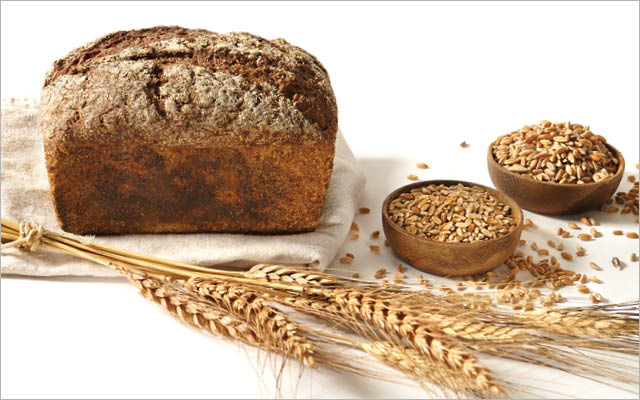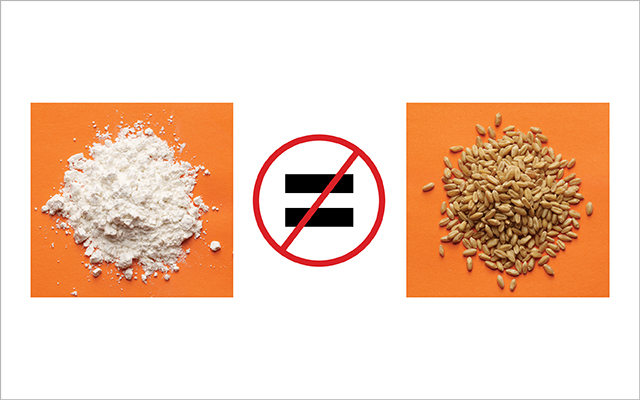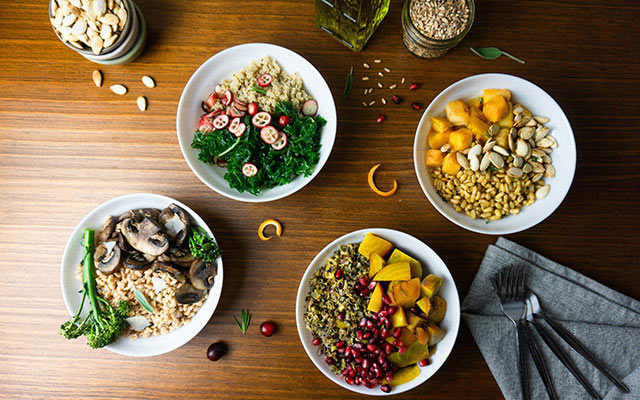When the U.S. Department of Agriculture and the Department of Health and Human Services released the most recent Dietary Guidelines for Americans, the updated recommendations turned some heads. Many of the messages were expected: Eat more fruits and vegetables, eat fewer sweets, and get regular exercise.
But one suggestion – the advice that most adults consume six 1-ounce servings of grain per day, at least half of them whole-grain products – seemed surprising, especially to low-carb fans. Could foods like bread, rice and pasta once again be considered good for us? Or is this just another case of an ill-advised, industry-driven government “food pyramid scheme” – the kind that helped our nation get so fat in the first place?
These are questions worth pondering – and worth putting into context. First, it’s important to note that the old Food Pyramid’s graphic appeared to recommend anywhere from six to 11 servings of grains, without specifying whole grains or clearly adjusting for age, gender or activity level. So, in specifying six servings (for a 2,000-calorie diet), clarifying a 1-ounce portion size and emphasizing whole grains, the newer guidelines appear to be at least qualifying their formerly unabashed pro-grain attitude, an attitude that many health experts suggested might be more representative of industry and agricultural special interests than scientific common sense.
Second, it’s important to keep in mind that the old six-serving recommendation in the guidelines was very general and based on a 2,000-calorie diet, which may or may not be appropriate for people of various sizes, activity levels and caloric needs. But the new Food Pyramid (now available at www.mypyramid.gov) is an interactive module that lets you plug in your age, gender and activity stats. It may suggest anywhere from five to 10 servings of grains for an adult, depending on what you enter and your corresponding caloric needs.
Third, while the new emphasis on whole grains is encouraging, the current guidelines still imply that it’s fine to get fully half your recommended grain intake from refined-grain sources, an assertion that some nutrition experts reject, particularly in the face of mounting public health problems like obesity and diabetes.
Finally, for the millions of people struggling with wheat and gluten allergies, sensitivities, and intolerances, any pro-grain advice must be taken with a grain of salt. According to the 2004 National Institutes of Health Consensus Conference, nearly 3 million people suffer from celiac disease, an autoimmune response to the gluten protein in wheat and certain other grains.
So where does this leave you, the average consumer?
Still largely up to your own devices, in terms of deciding what works for you and your body. But when it comes to making wise refined-grain or whole-grain decisions, there’s no question that whole grains have a whole lot more to offer.
Common Sense
Most nutrition experts advocate balancing consumption of the three macronutrients required by our body – protein, fats and carbohydrates – and that includes eating whole grains.
Whole grains typically have a lower glycemic index than refined ones. They contain more protein, do a better job of satisfying hunger, and are an excellent fuel source for athletes and active people. Yet whole grains remain anything but a staple in our current diet. According to the 2002 National Health and Nutrition Examination Survey, the average American consumes less than one serving of whole grains per day. The new dietary guidelines suggest that we eat at least three 1-ounce servings of whole grains daily.
The term “serving size” can be confusing, though: A large whole-grain bagel may count for as many as four servings.
Examples of 1-ounce servings, according to the guidelines, could be a half cup of cooked brown rice, a single slice of bread or one cup of ready-to-eat cereal flakes. The term “serving size” can be confusing, though: A large whole-grain bagel may count for as many as four servings. Fill your measuring cup with a denser cereal, like Grape Nuts or granola, and you could be getting two servings instead of one. Make a sandwich with two larger-than-average slices of bread and you may very well have taken care of your 3-ounce quota.
What Is Considered Whole Grain?
To understand the value of adding more whole grains to your diet, it helps to know what a whole grain is. In its most natural state, a whole grain is the entire seed of the plant. It includes the bran (the outer shell, which contains most of the seed’s fiber), the germ (the part inside the seed from which a new plant sprouts) and the endosperm (the largest part of the kernel, which supplies energy to the growing plant). A whole-grain food is any food that retains all three properties of the grain.
For a product to be labeled “whole grain,” the whole grain contained in that food need not be intact – it can be crushed or ground or even in the form of flour – but the portion used in the food must contain the same proportion of bran, germ and endosperm as before it was processed. (For examples of whole-grain products, see “Beyond Bread,” below.)
Refined grains, such as white rice and white flour, contain mostly the white endosperm portion of the kernel. The bran and germ have been removed.
“Back in the mid-1800s, the advent of the roller mill allowed for easy production of fine-grain flour,” explains Len Marquart, PhD, assistant professor in the Department of Food Science and Nutrition at the University of Minnesota. “Before long, it was the ‘in’ thing to be eating refined flour, because it’s what the upper class was eating.” That standard continued well into the 20th century, he notes: “By the mid-1950s, everybody was used to eating soft, squishy bread.” And we were well on our way to nutritional trouble.
Super Seeds
Casting aside the bran and germ had some major health consequences.
The bran and germ, researchers later learned, were the most important of the kernel components – containing about 25 percent of the grain’s protein and 17 key nutrients, as well as 83 percent of its antioxidants. In the 1970s, scientists began looking into the benefits of fiber, which was then associated primarily with relieving constipation, and which is now more closely associated with cancer prevention and general health. Gradually, researchers discovered the disease-preventing benefits of whole grains and other whole foods such as fruits and vegetables. That led to the dietary-guidelines recommendations we have today.
In July 1999, the U.S. Food and Drug Administration also authorized a “health claim notification” that could be printed on labels of foods that contain 51 percent or more whole grain: “Diets rich in whole-grain foods and other plant foods and low in total fat, saturated fat and cholesterol may help reduce the risk of heart disease and certain cancers.”
But what exactly is it that makes whole grains so good for us? Consider what’s in them:
- Antioxidants – compounds, such as vitamin E, lignans and selenium, that slow the rate of damage caused by oxygen byproducts. Antioxidants capture free radicals, which are produced when the body burns energy. Free radicals can wreak havoc on our cells, tissues, even DNA.
- Phytoestrogens – naturally occurring plant compounds that can change estrogen metabolism and may help protect women against breast cancer and men against prostate cancer.
- Phenolic and phytic acids – chemicals that have been shown to reduce the formation and presence of tumors in animals.
- Flavonoids – complex molecules that prevent cancer.
- Fiber – indigestible carbohydrates shown to reduce the risk of heart disease, diabetes, diverticular disease (a condition of the large intestine) and constipation.
- Wheat from chaff
Once you’ve decided to seek out more whole-grain products, you have to know what to look for on the label or packaging. “If it lists whole grain or whole wheat as the first ingredient, it has to be a whole grain,” says Joanne Lupton, PhD, professor of nutrition at Texas A&M University and a member of the 2005 Dietary Guidelines Advisory Committee.
But buyer beware: Even if whole grain is listed as the second ingredient, its spot on the label is not a very precise measure of the product’s whole-grain content.
But buyer beware: Even if whole grain is listed as the second ingredient, its spot on the label is not a very precise measure of the product’s whole-grain content. According to the Whole Grains Council, a food-industry and scientific consortium dedicated to increasing public awareness of whole-grains’ benefits, it is possible, in theory, for such a product to contain as little as 1 percent whole grain.
One way that the Whole Grains Council assists consumers in identifying whole grains is through the Whole Grain Stamp, which labels products as “good,” “excellent” or “100 percent” sources of whole grains. (For more information on what qualifies, visit www.wholegrainscouncil.org.) “We hope that the stamp will make it a lot easier for consumers to navigate their whole-grains options and meet the recommended daily intake,” says Cynthia Harriman, coordinator of the Whole Grains Council. More than a dozen milling and baking companies, including some industry leaders, are changing their packaging to include the stamp on qualifying products, says Harriman, and more plan to follow suit.
Keep in mind, though, that many kinds of whole-grain products may also contain sugar, trans fats and other less-than-healthy ingredients, so it’s important to evaluate the entire label, not just the whole-grain ingredients, in determining a product’s overall nutritional worth.
Also, you should strive to keep your total consumption of grains in proportion to your overall caloric intake, and to your intake of fresh vegetables in particular.
Bottom line: If you’re eating bread or pasta at every meal and not making veggies a dietary staple, you could easily be going overboard with your grains.
Reap the Rewards
While it can be challenging to pinpoint which products are good sources of whole grains, getting the recommended daily allotment doesn’t have to be difficult. A few tips:
- Substitute whole-wheat flour for white. It can replace as much as half the amount of white flour called for in any recipe without significantly affecting flavor or texture.
- Switch your morning routine. Breakfast that includes whole-grain cereal or toast instead of refined varieties will give you one to two servings of whole grains to jump-start your day.
- Use brown rice. Nutritionally, it’s much better than white rice. Or replace your regular, refined pasta with a whole-grain or partially whole-grain product.
- Try wheat alternatives. Whole-grain pastas, breads and crackers made from rice, quinoa, spelt and other mild-flavored grains can add nutritional and flavor variety to your meals.
- Don’t go overboard. It’s harder to stuff yourself on whole grains, but it’s also easy to forget that a single bagel can count as three to four servings, rather than one.While your next-door neighbor may still be married to a low-carb diet, nutritional experts are hopeful that the regular consumption of whole grains will become, well, ingrained in future dietary habits. “The low-carb craze definitely has a silver lining,” Marquart says. “It’s like what happened with fats: We got smarter about differentiating good from bad. Consumers are looking more closely now at whole grains, fiber, starch, sugars and the glycemic index. And they’re becoming more sophisticated in their selections. They’re no longer throwing the baby out with the bathwater.”
Good Sources of Whole Grains
A wide variety of whole-grain foods are as close as your neighborhood supermarket or co-op. Here’s what to look for in the aisles:
- Barley, one of the oldest cultivated grains, has a tough hull that is difficult to remove without altering the concentration of bran. Hulled barley takes longer to cook but maintains its whole-grain quality better than the more processed pearled barley, which cooks easily.
- Kamut, originating in Egypt, is an ancient precursor to wheat. Its rich, buttery taste is great in cereals, soups and casseroles. Kamut contains 20 to 40 percent more protein than common wheat and has up to 65 percent more amino acids. It’s also rich in vitamin E.
- Millet is a small, round grain that resembles couscous. Easy to digest and cook, it’s a tasty source of nutrients such as phosphorus, B vitamins and iron.
- Oats help lower cholesterol and protect the body from the often-damaging effects of low-density lipoprotein (LDL) cholesterol – the bad kind. Try steel-cut oats: They take about 20 minutes to cook but offer a nutty flavor and chewy texture. Instant oats in prepared packets, while still a whole-grain product, should be used with caution because they have added sugar. Also, because instant oats are processed more by the manufacturer and less by your own body, they may give you a more abrupt blood-sugar spike and less sustained energy.
- Quinoa, a staple food of the Incas, is a complete protein, containing all the essential amino acids our body needs. It can easily replace rice in meals because it cooks quickly, usually in 10 to 12 minutes. “Enjoy it with vegetables and either chicken or beef served over it,” says Len Marquart, a whole-grains researcher at the University of Minnesota. “It has a pleasant taste and is palatable for most people.”
- Spelt, another nutty, protein-packed ancestor of common wheat, comes in “berries” (the least modified version), flakes and flour. Spelt is a good source of B vitamins, dietary fiber and potassium.
- Wheatberries, as whole kernels of wheat are called, are a great alternative to rice. Cooking time ranges from 40 to 60 minutes (simply boil in a large pot of water), but the final product is chewy, tender and filling. For that reason, Marquart says, wheatberries have become a favorite with those watching their weight.
- Wild rice, now cultivated primarily in the Midwest and California, is not really a rice at all but the seed of an aquatic grass native to the upper Great Lakes region. Although it has less iron and calcium than brown rice, it has twice the protein and fiber, making it a tasty, flavorful alternative to other rice products.
This article originally appeared as “Great Grains” in the July/August 2005 issue of Experience Life.




This Post Has 0 Comments